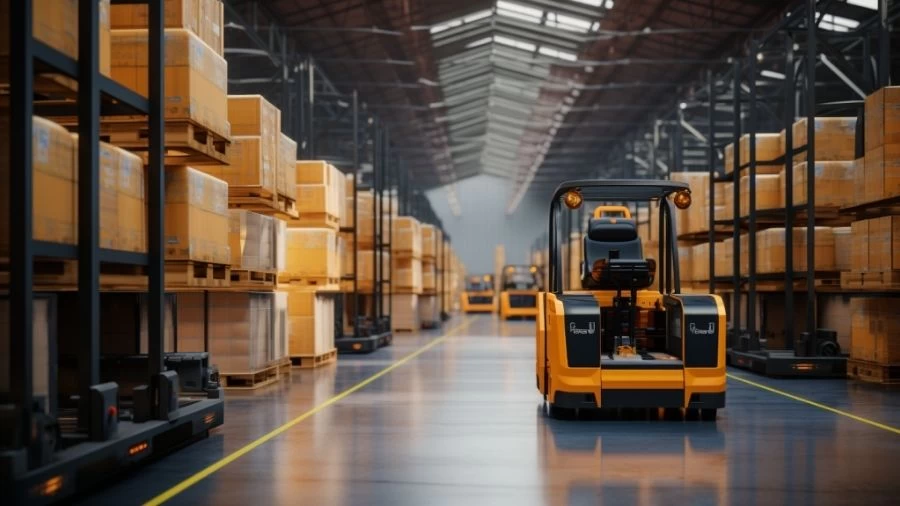
- Home »
- Technology »
- Is GreenBox Systems the Next Big Thing in AI Warehousing?
Is GreenBox Systems the Next Big Thing in AI Warehousing?
GreenBox Systems, a partnership between Symbotic and Softbank, is poised to revolutionize the world of AI-driven warehousing, with a successful track record in AI-powered robotic warehouse management systems.
Updated Oct 16, 2023
On This Page
Is GreenBox Systems the Next Big Thing in AI Warehousing?
GreenBox Systems, a collaboration between Symbotic and Softbank, is poised to disrupt the world of AI-powered warehousing. Symbotic's successful track record with major retailers like Walmart, Target, and Albertson's demonstrates its capability in AI-driven robotic warehouse management systems. Now, in partnership with Softbank, they're launching GreenBox Systems, a joint venture that aims to provide AI-powered logistics and warehousing as a service to smaller companies.
They project this to be a massive $500 billion market, potentially democratizing advanced warehousing technology and transforming the way smaller businesses handle their logistics. Industry experts are already impressed by GreenBox's potential, emphasizing the revolutionary impact it could have compared to traditional methods. While it's still in its early stages, GreenBox Systems appears to be a significant player in the AI warehousing arena.
GreenBox Systems could be a game-changer, providing access to advanced warehousing solutions for companies that previously couldn't afford the substantial investment. It has the potential to follow in the footsteps of cloud computing, which made high-end IT resources accessible to a broader audience.
This venture has garnered positive attention from experts who are recognizing the transformative power it offers. While it's yet to fully realize its potential, GreenBox Systems could very well be the next big thing in AI-powered warehousing, reshaping the industry landscape.
How Has Symbotic's Stock Performed After Going Public?
Since Symbotic went public in June 2022, its stock has experienced a remarkable surge, growing by more than 200%. This exceptional performance can be attributed to the innovative product it offers. Symbotic's system incorporates a fleet of autonomous robots that swiftly navigate warehouses at speeds of up to 25 mph.
These robots efficiently handle tasks like unloading boxes, picking orders, and optimizing storage within the warehouse using AI software. This not only minimizes wasted space but also enhances overall warehousing efficiency.
A significant feature of Symbotic's technology is its precision in inventory tracking down to individual cases, simplifying the matching of goods with incoming orders and automating the order picking process. Furthermore, it can customize outgoing pallet designs to suit the layout of the destination store, expediting unloading and shelf stocking.
The groundbreaking aspect of this technology lies in its potential to revolutionize business models, especially for large companies. It enables multiple firms to share the same warehouse, facilitating efficient shipping and reducing the need for substantial capital investment, akin to the way cloud computing allows clients to share common servers.
At MarketsHost, we build financial bridges. Explore, connect, and achieve your financial goals.
How Did Symbotic and Walmart Jointly Achieve Success?
The collaboration with Walmart played a significant role in making Rick Cohen a billionaire. The idea for Symbotic, the company behind the collaboration, emerged from Cohen's vision when he was running his family's grocery distribution company, C&S Wholesale Grocery.
Under his leadership, C&S Wholesale Grocery grew from $14 million in annual revenue in 1974 to a massive $33 billion. Symbotic was founded in 2006 and operated in stealth mode for several years, honing its technology in partnership with Walmart.
Cohen's involvement with Symbotic and the success of this collaboration with Walmart have propelled him to the status of one of America's wealthiest individuals, with a net worth estimated around $15.9 billion according to Forbes. Symbotic partnered with Softbank to create GreenBox as a way to conserve capital. Initially, Softbank provided 65% of the capital, and Symbotic contributed 35% for a total of $100 million.
Analysts anticipate that the venture will require additional capital, which might be raised by GreenBox itself through borrowing in the bond market. Symbotic plans to maintain its equity stake in the joint venture at around 35% by using its share of the profits from GreenBox's sales. The joint venture will acquire software from Symbotic and offer a complete package of warehouse space, equipment, and related services to tenants.
Is GreenBox Systems the Next Big Thing in AI Warehousing - FAQs
1. What is GreenBox Systems?
GreenBox Systems is a joint venture between SoftBank Group Corp. and Symbotic Inc., offering Warehouse-as-a-Service solutions.
2. How does GreenBox Systems differ from WeWork's real estate venture?
While WeWork aimed to blend technology with real estate without a clear technological advantage, GreenBox's core focus is on technology-driven solutions for warehouse efficiency.
3. What's the market potential for GreenBox's services?
GreenBox expands Symbotic's potential market, with an estimated $432 billion for its primary market and an additional $500 billion targeting smaller companies.
4. How has Symbotic's stock performed since going public?
Symbotic's stock has surged by over 200% since going public in June 2022.
5. What is the main goal of GreenBox Systems?
GreenBox aims to leverage Symbotic's AI-powered robotics and software technology to automate supply chain networks globally, offering efficient solutions for single and multi-tenant warehouses.



